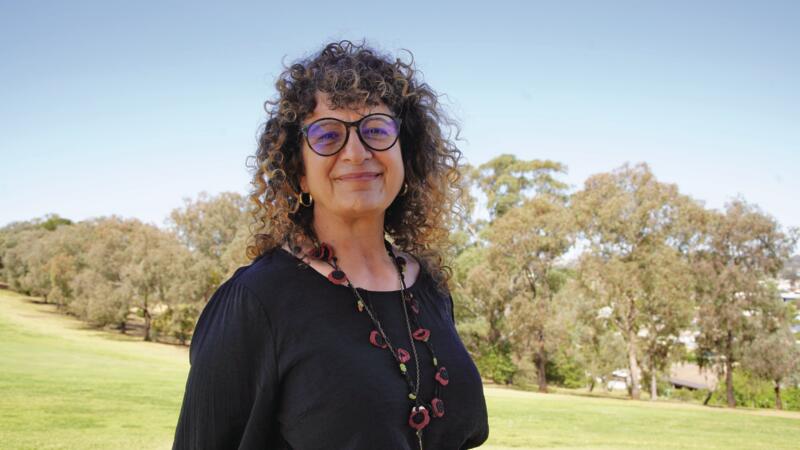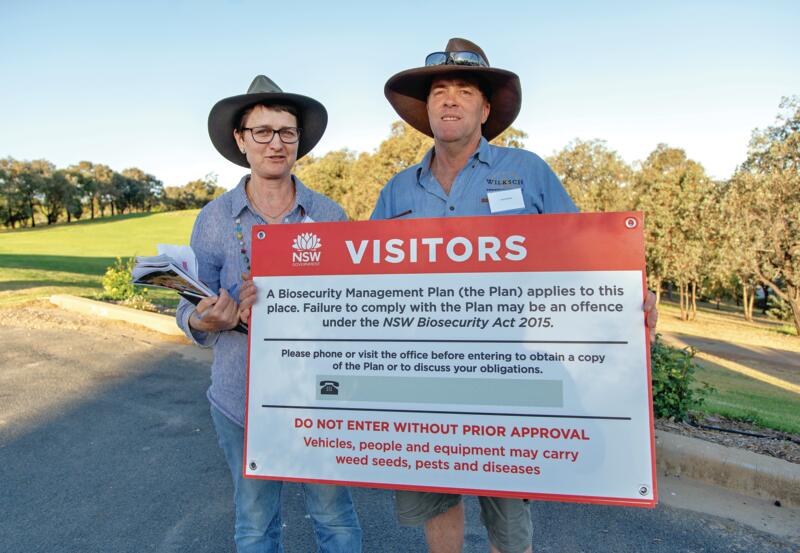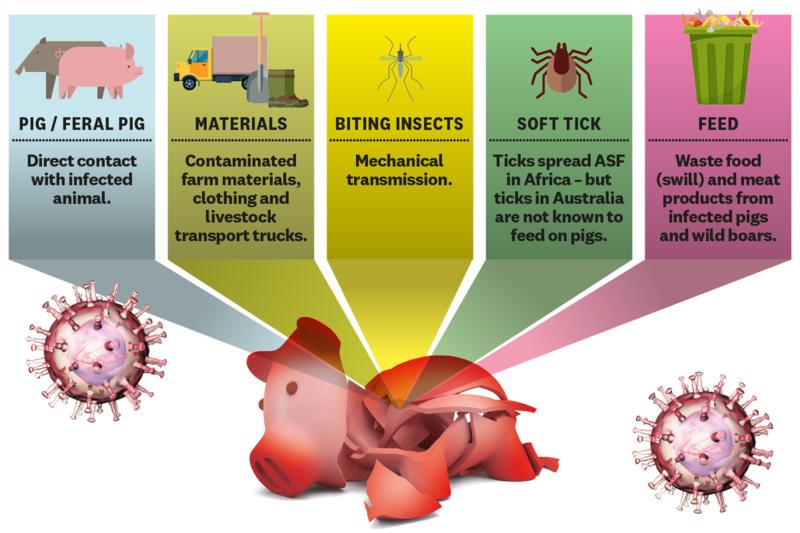LIKE many farmers working on small family properties, Simon and Kirsty Wilksch don’t have time to take holidays. And they usually couldn’t fit in the three-hour drive from Culcairn to Young to attend a forum about pork.
This year, however, was different. With African swine fever (ASF) reaching Timor-Leste, less than 700km from Australia’s borders, our country’s pig farmers are “terrified” and, like everyone, the couple wanted information on what to do about it.
Normally, NSW Farmers’ pork forum attracts about 30 people. This year Young Golf Club was flat out making ham sandwiches (of course) for more than 100 delegates, including farmers, processors, saleyard and feed-mill agents and Local Land Services and Department of Primary Industries representatives.
.jpg) NSW Farmers’ Pork Committee chair Ean Pollard addresses delegates at the pork forum in Young. Photography by John Worrell.
NSW Farmers’ Pork Committee chair Ean Pollard addresses delegates at the pork forum in Young. Photography by John Worrell.
“All I can say is there’s nothing like an exotic disease to bring people together,” NSW Farmers’ Pork Committee chair Ean Pollard observed. “We didn’t quite expect this turnout but ASF is the hot topic at the moment. We don’t want it in Australia and everyone is concerned.”
The main aim of the forum was to get producers to look at their biosecurity and consider what they’d do if there was an outbreak.
It was daunting and, at times confronting as animal emergency preparedness specialist Duncan Worsfold spoke about depopulation, disposal and decontamination. Showing shocking photographs of the aftermath of avian infections, he urged farmers to have a pre-written plan for exactly what they’d do if their pigs were affected.
RELATED ARTICLES:
Swine fever prompts farmers to raise biosecurity controls
Meet the detector dogs protecting Australia from pests and diseases
Meanwhile Dr Pat Mitchell, who sits on the NSW Farmers Biosecurity Committee, urged everyone to imagine the following scenario. “A group of young blokes go out into the forest for a drinking session. One works at an outdoor farm, the other at a feed mill. They come across a dead feral pig. Boys having a strange sense of humour grab bits and chase each other around.
“They go home and say nothing but that feed mill delivers to a lot of places and three months later a strange wasting disease appears in a piggery. The verdict comes back: it’s ASF. Suddenly there are no stock movements in NSW for two weeks. I want you to think what you might do.
 Dr Pat Mitchell, Member of the Biosecurity Committee, NSW Farmers.
Dr Pat Mitchell, Member of the Biosecurity Committee, NSW Farmers.
“If you can’t move pigs for two weeks, how long would your feed last? Most people wouldn’t have more than two to three weeks in stock. Where will you get extra feed? If you can’t get feed, who would you euthanise? If you use AI [artificial insemination], what would you do if you couldn’t bring in semen?
“You also need to think how you’ll respond and recover if there’s an outbreak. Bulletproof your plan by discussing it with other people. We have to be like boy scouts with this stuff. We have to be prepared.”
“Preparedness is key. The more prepared we are, the less panic there will be if there is an outbreak,” agreed Ean.
Farm biosecurity made top priority for pork industry
Pig farmers reckon they are a cohesive bunch. Protecting themselves means protecting their mates and NSW Farmers staff made sure everyone had a biosecurity checklist to take home. When NSW chief veterinary officer Dr Sarah Britton advised saving the Emergency Animal Disease Watch Hotline onto phones, everyone immediately tapped in the number.
“Technically we have two defences,” Ean explained. “One is our national borders and we’re working strongly there on things like more screening and signage and bigger fines for false declarations. However, the other border is the farm gate and there’s a host of things farmers can do to increase biosecurity there.”
RELATED: How international trade and travel can threaten Australia’s biosecurity
Fellow Pork Committee member Andree Rowntree from Windridge Farms added, “It’s the biggest issue our industry has ever faced and it’s not even here yet. We’ve all gone out of our way to call everyone with pigs because everyone needs to know about swine fever. I rang my butcher who has one pig and people who have 1,000 pigs.”
.jpg) Pork Committee member Andree Rowntree.
Pork Committee member Andree Rowntree.
Running a large intensive piggery in Young, Andree already has strict biosecurity protocol but has tightened up. “We’re asking everyone: have you been overseas, do you have a pet pig, have you had contact with other pigs? We’re being hyper vigilant.”
Her sister Edwina Beveridge of nearby
Blantyre Farms agreed. Her workers may now find themselves changing their boots ten times a day, she said, but she doesn’t want to risk the tiniest contamination.
“We’ve also stopped staff bringing pork products into work which is like shooting yourself in the foot, because we don’t want anyone to stop eating pork. But we don’t want anything affecting our pigs.
“Although ASF has spread like wildfire through China and South-East Asia, some countries in Europe have managed to hold and eradicate ASF so we want to be like that if we do get an infection.”
David Refalo from Canowindra is one of the smaller pork farmers and the Young Farmers representative on the Pork Committee. He currently has about 30 sows and supplies free-range suckling pigs to the Sydney and Canberra butcher/restaurant trade.
RELATED ARTICLES:
Brothers' paddock-to-plate beef business masters supply chain
Clever beef farmers create innovative market for bone broth
Family run sustainable paddock-to-plate business tastes good
Despite his pigs being free range, he has the same biosecurity protocols as an intensive piggery, with separate “clean” and “dirty” areas. Only David and his workers enter the “clean” area where the pigs live.
.jpg) David Refalo from Canowindra is small pig farmer and Young Farmers Pork Committee representative.
David Refalo from Canowindra is small pig farmer and Young Farmers Pork Committee representative.
Like everyone he fears the illegal importation of contaminated pork and because of that believes Australia has a “medium chance” of seeing an ASF infection. “Infected meat only needs to be fed to one pig and we could have a problem,” he says.
With the virus able to survive for many months in frozen pork, it’s not surprising he’s concerned and believes one of the biggest issues is backyard pig owners feeding their animals swill – food scraps or food waste that contain or have been in contact with meat or meat products, which is banned. “Although most small producers know it’s illegal, a few don’t care and that’s the real risk,” David says.
“I’d like to see small pig keepers banned if they’re intentionally doing the wrong thing, but it would be very hard to police.”
Feral pigs increase risk of widespread African swine fever outbreak
The other big concern for pig farmers is Australia’s 24 million feral pig population. “They’re in every state and are more mobile in drought as they seek food and water,” observed SunPork Farms chief executive Paul O’Leary.
“We’ve asked the government what can be done but it’s a question that’s remained in the too hard basket.”
Coincidentally, one person who didn’t make the forum was
Australian Pork Limited CEO Margo Andrae – and that was because she was at a Senate estimates committee in Canberra asking exactly that question.
Since that meeting, the federal government has announced it will appoint a National Feral Pig Coordinator to work with state and territory governments, industry, researchers, natural resource management groups and the community to crack down on feral pig populations.
 Kirsty and Simon Wilksch with a biosecurity sign with information for visitors visiting their farm.
Kirsty and Simon Wilksch with a biosecurity sign with information for visitors visiting their farm.
After six hours of talks and questions at the forum, Simon and Kirsty Wilksch climbed back into their car to drive the three hours home, agreeing, “It was absolutely and definitely worth coming. It’s made us think about the things we need to do.”
Already on their plan is investigating fencing around their pig sheds and truck washes, preventing cars coming in and out, and ensuring footbaths and thorough hand and forearm washing are carried out by all workers.
Sadly, they said, they were also contemplating putting an end to school visits. They’ve always encouraged pupils from a local school to
come to the farm to learn about agriculture. “Now we might have to take photographs and go to the school to give talks about what we do,” said Simon.
What the government is doing to stop African swine fever
.jpg) NSW Farmers’ regional services manager Catriona McAuliffe (to the left) helps members find essential information at the pork forum.
NSW Farmers’ regional services manager Catriona McAuliffe (to the left) helps members find essential information at the pork forum.
- A ‘Don’t pack pork!’ campaign aimed at overseas visitors and translated into several languages. University students and towns are being targeted as it’s been shown that’s where most overseas pork products are sent.
- Extra training to border staff particularly in Darwin where a detector dog has been introduced. There is increased scrutiny of packages from affected countries. Samples are being collected to test for ASF and there are increased fines for passengers failing to declare items of biosecurity interest.
- Import bans on pork products from Belgium, where ASF has been detected.
- Identification of potential risks, such as passengers and food waste from cargo ships and agricultural shows.
- A campaign to remind those swill-feeding that it’s illegal and dangerous. Examples include reusing restaurant and bakery food that might contain meat products to feed pigs.
- Weekly Animal Health Committee meetings to discuss ASF, so if there is an outbreak, there’s a national agreement on policy, taking into account circumstance and risk.
- Regular pig movements between Victoria and NSW mapped to inform what permits will be needed, and meetings held with meat processors to agree on protocols.
- People with backyard pigs identified. One project is targeting online forums, including Gumtree and Facebook, and asking them to ensure all pigs sold online have a property identification code.
- Data from PigPass (the pork industry’s national vendor declaration scheme) and Annual Land and Stock Return used to identify those who may not be compliant – with Local Land Services following up with education and, if necessary, compliance notices.
- Maps of feral pig populations produced and overlaid on all the piggeries in NSW so those at risk of contact can be identified and risk minimised by, for instance, shooting out buffer zones.
Source: Dr Lechelle van Breda, ASF coordinator at Australian Pork Limited, and DR Sarah Britton, NSW chief veterinary officer
How will government bodies respond to an outbreak of African swine
- Once notified of a possible outbreak, a government vet will come out to take samples for testing. Results should be returned within six hours.
- If it’s positive, the chief veterinary officer will be informed and a control centre set up. Within 24 hours an emergency disease response plan will be written up and ready to go.
- Movement controls will be established and infected farms will be placed under a Biosecurity Emergency Order. Officials will work on identifying the index case, the source and spread including tracing pigs, people, vehicles, equipment and products.
- Disease control zones will be set up so that farmers not affected have as much business continuity and normality as possible.
- Because the disease needs to be eradicated, infected farms will have to destroy all their pigs, dispose of the bodies and decontaminate the premises.
How can farmers prevent the spread of African swine fever?

- Purchase recommended chemicals for decontamination.
- Have contingency plans in case you can’t get on and off your property due to movement restrictions. This includes what you’ll do if you can’t get in feed or health and husbandry items, how you’ll dispose of manure, how your business will be affected if you can’t sell pigs and what you’ll do if you don’t have room or feed for some animals.
- Consider how to deal with the media and public interest in an informed manner. ASF does not affect humans or public health or food safety.
- Have good fences to keep feral pigs out and control visitors. Low-interest loans may be available from the NSW Rural Assistance Authority.
- Maintain a single entrance for all deliveries, equipment and people. Keep records of visitors: where they’ve been, who/what they’ve been in contact with etc.
- Ensure visitors sign in to confirm they have showered and changed clothes since exposure to pigs.
- Provide clean clothes and boots for visitors.
- Provide staff with boots and overalls to wear in the piggery.
- Set up good hand and forearm washing or showers.
- Consider a truck wash.
- Keep non-farm vehicles outside the farm.
- Know every aspect of the farm business, from where the feed is bought to where the pigs are bought.
- If staff have been in contact with other pigs, give them an off-piggery role for 72 hours. If they’ve been to a country where Afircan swine fever has been reported, move them for one week. Staff should not go pig hunting.
- Encourage staff to monitor one another to ensure no-one even brings a ham sandwich on site.
- Ensure no products that have come into contact with meat go anywhere near pigs. Food scraps are a common cause of ASF spread in China.
- Complete the Piggery Biosecurity Audit Checklist in the National Farm Biosecurity Manual for Pork Production.
- Learn to recognise the symptoms of ASF.
- Isolate sick pigs. If you suspect ASF, call the Emergency Animal Disease Watch Hotline below.
- Keep records of losses and costs. If you do lose pigs, compensation will be available. 24-hour Emergency Animal Disease Watch Hotline 1800 675 888
Source: Dr Lechelle van Breda, ASF coordinator at Australian Pork Limited, and DR Sarah Britton, NSW chief veterinary officer
Symptoms of African swine fever in pigs
Vomiting and diarrhoea, abortions, red and purple blotches and lesions, fever, lethargy, pneumonia symptoms and unexplained deaths in pigs.
Incubation is three to 19 days so be aware that once you do spot it, the pig may have already been spreading it around the farm for several days.
Did you know?
African swine fever has no cure and once contracted the disease is almost always fatal to swine. Though highly contagious, the virus is not transmissible to humans.